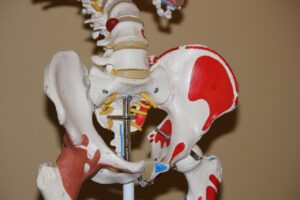
Pelvic Crossed Syndrome is a muscle imbalance syndrome. Muscle imbalance Syndrome is when some of your muscles become shortened/tight and overactive or weak and inhibited. Inhibition means that the neural (nerve) connection is absent, bypassed, incomplete, weak, or overridden. Moreover, this often happens to specific muscles. Typically, postural antigravity slow-twitch muscles tend to tighten and shorten. In contrast, the phasic fast twitch muscles usually weaken and elongate. Read on to learn more about West Palm Beach Chiropractor: Pelvic Crossed Syndrome.
Obviously, there are some differences in muscle strength which cause a normal imbalance. After all, not all muscles are equal. The smaller muscles tend to react rapidly and strongly to a stimulus and are called phasic. Similarly, the larger muscles hold our posture and are called tonic. And then certain movement patterns are notable. For example, internal (inward) rotation of the shoulder is stronger than external (outward) rotation of the shoulder. Additionally, the size and number of the muscles used for the particular movement matters. Alternatively, position also makes your balance of muscles stronger or weaker. However, there is another point of view clinically in regards to muscle imbalance; weakness and tightness. This type of muscle imbalance is dysfunctional and needs evaluation and treatment for correction.
West Palm Beach Chiropractor: What is Pelvic Crossed Syndrome?
Firstly, in Pelvic crossed syndrome there is an imbalance between the shortened tight hip flexors (e.g. iliopsoas, rectus femoris) and the tight lumbar erector spinae muscles (back extensors). So tight erector spinae and a tight iliopsoas muscle (hip flexor that’s made up of the psoas major, psoas minor, and iliacus muscles) with the weak and/or inhibited gluteal muscles will alter the pattern of hip extension during gait. A tight psoas may result in decreased hip extension as well. And imbalance is seen in weakened and/or inhibited (restrained function) gluteal and abdominal muscles.
Secondly, the tight hip flexors cause a slight flexion of the hip and an anterior (forward) pelvic tilt. Therefore, there is an increased lumbar lordosis (low back inward curve) with a concentration of pressure on the posterior (back) portion of the spinal disk (cushion of fibrocartilage between spinal vertebral bones) and decreased pressure on the anterior (front) spinal disk.
Thirdly, this would lead to compression of the lumbar spinal facet joints and increased pressure on the posterior disks. Ultimately, this would lead to more wear and tear and degeneration of the area.
Fourthly, this imbalance will cause problematic movement patterns especially in the L5-SI spinal region and cause hypermobility (excessive abnormal “motion” in the joints), irritation and pain.

West Palm Beach Chiropractor: Pelvic Crossed Syndrome Can Lead to a Pelvic Lateral (Side) Tilt
The hamstrings are often tight in this syndrome in order to lessen the pelvic tilt or are working harder due to weak gluteal muscles. And with weakness of the gluteus medius (muscle in outer surface of pelvis), tightness of the ipsilateral (same side) quadratus lumborum (low back muscle) and/or tensor fasciae late (hip muscle) this can alter the lateral (side) lumbopelvic (low back and pelvis) mechanics. Furthermore, this affects the gait and normal patterns of hip abduction (movement of hip away from midline). A tight quadratus lumborum could cause an increased elevation of the pelvis during gait. Finally, all this will lead to an increased movement of the pelvis. And you will develop a oblique/ lateral tilt in your pelvis.
West Palm Beach Chiropractor: Pelvic Crossed Syndrome Causes Dysfunctional Movement
In pelvic crossed syndrome, the pelvis is unable to perform normal hip extension. Moreover, to extend the hip, it is necessary for the pelvis to be tilted anteriorly (forward). However, the anterior pelvic tilt during gait may cause hypermobility (excessive motion) of the L4 and L5 spinal segments. Consequently, because of the abnormal motion pattern the lower lumbar spine can no longer work as the central point (fulcrum of lever where bones meet) around which movement occurs. The new central point is established in the lower thoracic (mid back) and upper lumbar (low back) area. Ultimately, combinations of tight and weak muscles in the syndrome lead to abnormal movement patterns that changes the biomechanics of joints. And this can lead to degenerative (wear and tear) changes and/or fixated joints.
West Palm Beach Chiropractor: Causes of Pelvic Crossed Syndrome
While there are many reasons for muscle imbalance, the most common cause may be chronic overuse or traumatic injury. Without proper treatment, there is a muscle elasticity change. Of course, having a sedentary lifestyle without a variety of movements also causes imbalance. Your connective tissue will shorten over time if left in the same position for long. Indeed, forced movements, stress, and even fatigue can lead to muscle imbalance. Next, this can even affect your central nervous system. Your nervous system remembers these imbalances of abnormal movement patterns. Also, even though appearing often together, a muscle that is tight, shortened and overactive is not the same as muscle spasm. This Tightness is due to hypertrophy (overgrowth) of the connective tissue.

West Palm Beach Chiropractor: Pelvic Crossed Syndrome Evaluation and Treatment at Meiri Chiropractic
Generally, practitioners test muscle strength to evaluate imbalance. With pelvic crossed syndrome which is a muscle imbalance syndrome, some Researchers (e.g. Vladimir Janda) introduced using movement patterns as part of the evaluation.
First, when the patient first presents, it’s important to get them out of pain. So the total treatment of the chronicity should begin with restoring as much joint motion by chiropractic adjustments/manipulation as possible and substantially decreasing pain before balancing the muscular system.
Second, for treatment of the muscle imbalance, post-isometric relaxation and proprioceptive neuromuscular facilitation (PNF) techniques are utilized.
Third, proprioceptive (sense that lets us perceive the location and movements of our body parts) training is incorporated. This is done with various balance activities (e.g. wobble boards, exercise balls, trampolines). Studies show these types of activities help the nervous system on a subconscious level regarding the new correct movement pattern. The result is improvement of gait, coordination, body posture, and stabilization.
West Palm Beach Chiropractor: Pelvic Crossed Syndrome
Do you suffer from Pelvic Crossed Syndrome? We offer excellent Chiropractic care in West Palm Beach, Florida. At Meiri Chiropractic, we spend the time necessary to examine, diagnose and treat every neuromusculoskeletal condition and various ailments you have. Indeed, Chiropractic is a holistic and natural way to not only treat pelvic crossed syndrome, but to keep your body in its best working condition. We have been offering effective chiropractic care in West Palm Beach since 2006. Many of our patients reviews note our excellence. Call us today at 561-253-8984 to make an appointment or to find out more about West Palm Beach Chiropractor: Pelvic Crossed Syndrome.
Reference: Warren Hammer, Functional Soft Tissue Examination and Treatment by Manual Methods 3rd edition